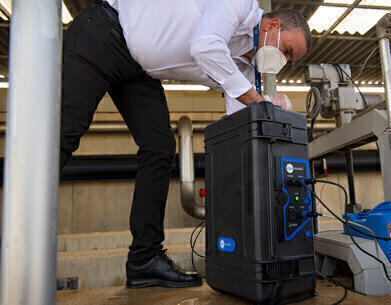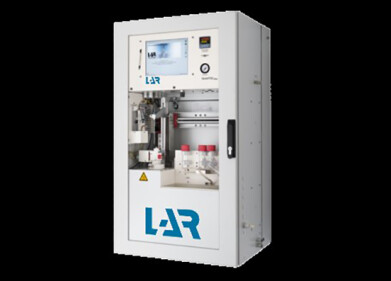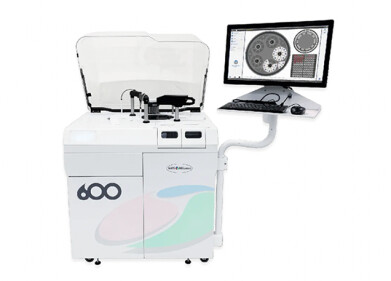Wastewater analysis
What is the role of real-time nitrate and nitrite monitoring in achieving net zero wastewater treatment?
May 24 2021
There is no one silver bullet for achieving net zero. However, improved process control and shortcut biological nitrogen removal, enabled through real-time nitrate and nitrite monitoring, can significantly reduce electricity demand for aeration, writes John McGrath, Director, Aquamonitrix.
Energy-efficient wastewater treatment is on the agenda for utilities everywhere as part of the drive to net zero, climate change abatement, the circular economy and pressures to play an increasingly positive role in the energy-water nexus.
Beyond purely environmental forces, resource efficiency may cut right to the economic heart of the wastewater treatment plant of the future. Energy use currently accounts for about a third of all operational costs in the average WWTP, and that figure could potentially increase if utilities are tasked with more stringent regulations for removing nutrients, pharmaceutical and personal care products and other contaminants of emerging concern.
The paradox is that the energy (chemical, thermal, etc.) locked up in wastewater is about six to nine times higher than the electric energy needed for its treatment, according to estimates by Andrea G. Capodaglio and Gustaf Olsson in their 2019 paper ‘Energy Issues in Sustainable Urban Wastewater Management’.
The theory, then, is that even if a fraction of this energy could be practically harnessed, the WWTP of the future could be a net energy producer.
In the here and now, a growing number of medium to large WWTP operators view anaerobic digestion of waste sludge as their best option for energy recovery. The resultant methane biogas has potential applications in space heating, vehicle fuel, or, as proposed by Capodaglio and Olsson, in high-efficiency combined heat and power plants.
Even with this scenario, however, existing AD technology would only meet about half of the average WWTP’s energy requirements. So, carbon-neutral, renewable energy sources, such as wind and solar power, coupled with more energy-efficient treatment processes, are also required.
Secondary treatment, where biological nitrogen removal takes place, is undoubtedly the most obvious target for optimisation, since this requires aeration - the single most energy-intensive operation in conventional WWTPs, accounting for a whopping average of 50 per cent of total site energy consumption.
Conventional biological nitrogen removal is a three-stage process. First nitrification occurs via autotrophic bacteria in two, sometimes parallel, steps. Ammonium is oxidised to nitrite by ammonia-oxidizing bacteria (AOB), and nitrite is, in turn, oxidised to nitrate by nitrite-oxidising bacteria (NOB). High levels of aeration are required to prevent dissolved oxygen becoming a rate-limiting factor.
This is followed by denitrification, a reduction process, whereby nitrate is reduced back again to nitrite, and, in turn, nitrite is converted to nitrogen gas. Denitrification is performed by heterotrophic bacteria that require a carbon source.
Of growing interest, shortcut biological nitrogen removal (SBNR) offers the potential to dramatically reduce aeration requirements. The term can be confusing, however, as sometimes it is used to describe a shortcut known as nitrite shunt, while other times, it is used to describe the ‘anammox’ process.
The nitrite shunt approach exploits the fact that nitrite is an intermediate in both the nitrification and denitrification steps of conventional BNR. Here the ‘shortcut’ is achieved by stopping the nitrification process at nitrite, which is then reduced directly to nitrogen gas.
A variant form of SBNR also inhibits nitrate formation but then uses bacteria that were discovered in the 1990s to be capable of anaerobic ammonium oxidisation (anammox). In the first step, half the ammonium is oxidised to nitrite, and in the second step, the remaining ammonium converted to nitrogen gas, using the nitrite as the substrate.
Both processes allow for significant aeration energy savings. Not only that, but the need for a carbon source in the second step is either reduced or eliminated, which enables operators to increase carbon harvest in primary treatment processes.
The key to enabling either of the above routes lies in creating conditions favouring the growth of the nitrite-producing AOB (ammonia-oxidising bacteria) at the expense of the nitrate-producing NOB (nitrite-oxidising bacteria).
In this regard, shortcut nitrogen removal can be seen as a natural partner for anaerobic digestion as the promotion of AOB and inhibition of NOB is favoured by the warm, ammonia-rich effluent typical of AD waste solids, often referred to as side-stream or reject water.
Achieving shortcut nitrogen removal in ‘mainstream’ cold, dilute wastewater is also possible. For instance, in 2016, Watercare Services Limited demonstrated full-scale nitrite shunt at the Mangere and Rosedale Wastewater Treatment Plants in New Zealand. However, process control is a key challenge.
This is where Aquamonitrix® believe their eponymous Aquamonitrix® analyser can have a game-changing impact. Nitrate is traditionally measured by ISEs (ion selective electrodes) or UV analysers. Drift is a generic issue with ISE sensors, while UV probes require expensive sampling systems to perform in challenging wastewater matrices.
In contrast, Aquamonitrix® provides real-time accuracy and precision above 90 per cent with minimal requirements for servicing or maintenance intervention. All analyte concentration data and system control data are automatically transmitted to the proprietary IoT platform or SCADA.
As the analyser uses a sample loop approach, and only ca. 500 µL of sample is used per analysis, the simple in-built sampling system is all that is required for most deployment cases, and even in activated sludge, a simple, low-cost centripetal filter sample system or settlement is all that is needed.
Not only that but Aquamonitrix® provides simultaneous nitrite and nitrate monitoring. These capabilities mean that Aquamonitrix® can, for the first time ever, offer researchers, designers and operators the tools to truly get to grips with what is happening in biological nitrogen removal.
The prospect of mainstream short-cut biological nitrogen removal was described as a “paradigm shift for the industry, offering the opportunity for sustainable wastewater treatment, energy neutral or even energy positive facilities and dramatic reductions in treatment costs…[with] widespread environmental, economic and societal benefits” by Pusker Raj Regmi, Old Dominion University, Virginia, in his 2014 thesis ‘Feasibility of Mainstream Nitrite Oxidizing Bacteria Out-Selection and Anammox Polishing for Enhanced Nitrogen Removal’.
Given that nitrate and nitrite are intermediates in the single most energy-intensive conversion in conventional wastewater treatment, a robust method to monitor them in real-time is likely to be a key enabler in process optimisation - even without SBNR.
The US Electric Power Research Institute, for instance, has estimated that 10 to 20 per cent energy savings can be achieved in wastewater facilities simply through better control and optimisation of the process.
Likewise, a better understanding of the molecular processes and reaction kinetics that occur during biological wastewater treatment and better characterisation of the synergistic interactions that occur among diverse microbial communities has been identified as an important enabler of the energy-positive wastewater treatment plant of the future, by an interagency working group reporting to National Science Foundation, U.S. Department of Energy, U.S. Environmental Protection Agency in 2015.
Aquamonitrix® is currently being trialled by utilities in wastewater treatment plants in Ireland, the UK and Spain.
Digital Edition
AET 29.2 May 2025
May 2025
Water / Wastewater- From Effluent to Excellence: Microbiological assessment of a containerized modular water reuse pilot system- Without water everything comes to a haltAir Monitoring- Probe Sampli...
View all digital editions
Events
Jun 08 2025 Denver, CO, USA
Jun 09 2025 Raleigh, NC, USA
Jun 10 2025 Toulouse, France
Jun 11 2025 Copenhagen, Denmark
Jun 17 2025 Guangzhou, China











.jpg)










